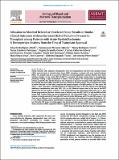Por favor, use este identificador para citar o enlazar a este item:
http://hdl.handle.net/10261/201648COMPARTIR / EXPORTAR:
 SHARE SHARE
 CORE
BASE CORE
BASE
|
|
| Visualizar otros formatos: MARC | Dublin Core | RDF | ORE | MODS | METS | DIDL | DATACITE | |

| Título: | Allocation to Matched Related or Unrelated Donor Results in Similar Clinical Outcomes without Increased Risk of Failure to Proceed to Transplant among Patients with Acute Myeloid Leukemia: A Retrospective Analysis from the Time of Transplant Approval |
Autor: | Rodríguez-Arbolí, Eduardo CSIC ORCID; Márquez-Malaver, Francisco José; Rodríguez-Torres, Nancy; Caballero-Velázquez, Teresa CSIC ORCID; Escamilla-Gómez, Virginia CSIC ORCID; Calderón-Cabrera, Cristina CSIC; Falantes-González, José Francisco CSIC ORCID; Solé Rodriguez, María; García-Ramírez, Patricia; Moya-Arnao, María; Carreras, Enric; Espigado, Ildefonso CSIC ORCID; Pérez-Simón, José A. CSIC ORCID | Palabras clave: | Acute myeloid leukemia Matched related donor Unrelated donor |
Fecha de publicación: | ene-2019 | Editor: | Elsevier | Citación: | Biology of Blood and Marrow Transplantation 25(1): 183-190 (2019) | Resumen: | Clinical outcomes after allogeneic hematopoietic stem cell transplantation (allo-SCT) from unrelated donors (URDs) approach those of matched related donor (MRD) transplants in patients with acute myeloid leukemia (AML). Yet, available data fail to account for differences in pretransplantation outcomes between these donor selection strategies. In this regard, URD allo-HSCT is associated with longer waiting times to transplantation, potentially resulting in higher probabilities of failure to reach transplant. We retrospectively analyzed 108 AML patients accepted for first allo-HSCT from the time of approval to proceed to transplant. Fifty-eight (54%) patients were initially allocated to MRD, while URD search was initiated in 50 (46%) patients. Time to transplant was longer in patients allocated to a URD when compared with patients assigned to an MRD (median 142 days versus 100 days; p < .001). Forty-three of 58 (74%) patients in the MRD group and 35 of 50 (70%) patients in the URD group underwent transplantation (odds ratio [OR], 1.22; p = .63). Advanced disease status at the time of allo-HSCT approval was the only predictor of failure to reach transplantation in the multivariate analysis (OR, 4.78; p = .001). Disease progression was the most common cause of failure to reach allo-HSCT (66.7%) in both the MRD and URD groups. With a median follow-up from transplantation of 14.5 (interquartile range, 5 to 29) months, the 2-year estimate of overall survival (OS) from allo-HSCT was 46% in the MRD group and 57% in the URD group (p = .54). There were no differences in OS according to donor type allocation in the multivariate analysis (hazard ratio, 1.01; p = .83). When including patients from the time of transplant approval, 2-year OS was 39% in the MRD group versus 42% in the URD group. Our study suggests that allocation of AML patients to URDs may result in comparable clinical outcomes to MRD assignment without a significant increase in the risk of failure to reach transplant. | Versión del editor: | https://doi.org/10.1016/j.bbmt.2018.08.019 | URI: | http://hdl.handle.net/10261/201648 | DOI: | 10.1016/j.bbmt.2018.08.019 | ISSN: | 1083-8791 |
| Aparece en las colecciones: | (IBIS) Artículos |
Ficheros en este ítem:
| Fichero | Descripción | Tamaño | Formato | |
|---|---|---|---|---|
| 1-s2.0-S1083879118304907-main.pdf | 906,34 kB | Adobe PDF |  Visualizar/Abrir |
CORE Recommender
SCOPUSTM
Citations
2
checked on 08-abr-2024
WEB OF SCIENCETM
Citations
1
checked on 28-feb-2024
Page view(s)
169
checked on 18-abr-2024
Download(s)
154
checked on 18-abr-2024
Google ScholarTM
Check
Altmetric
Altmetric
Este item está licenciado bajo una Licencia Creative Commons

